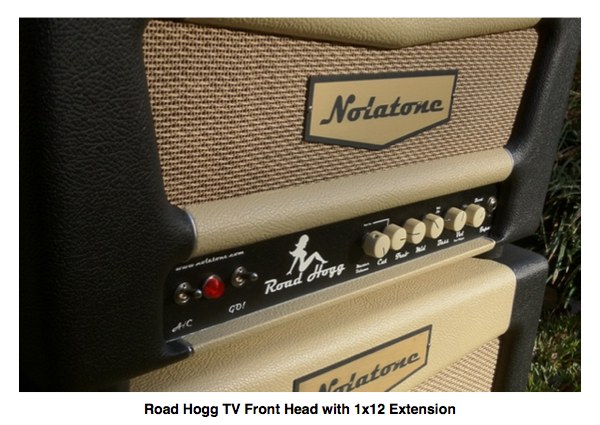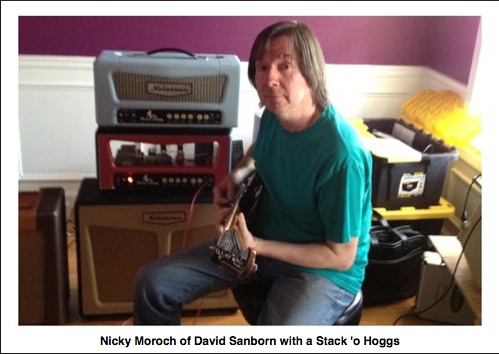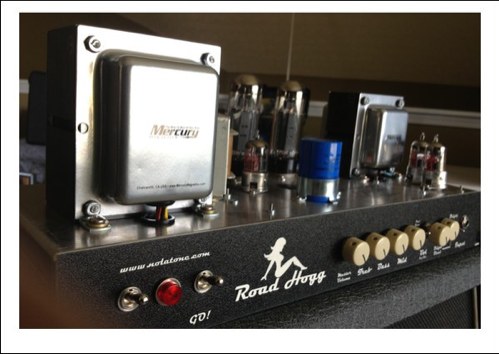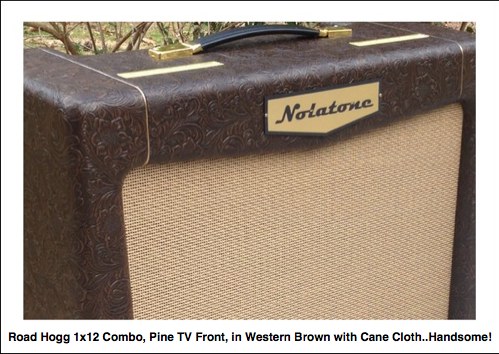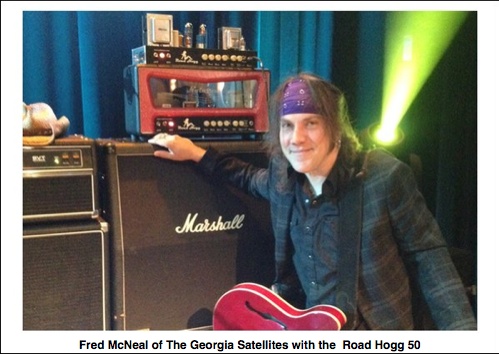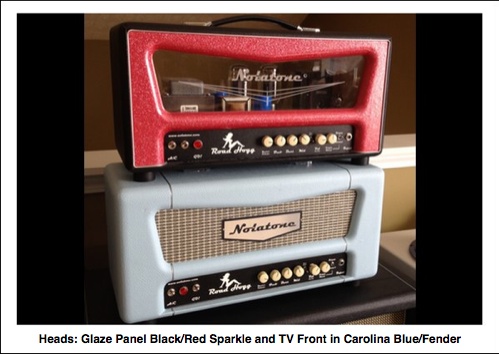

| Power Output | 37 Watts |
| Output Tubes | 2 - KT66 (Cathode Bias) |
| Preamp Tubes | 1 - 12dw7/ecc832, 2 - 12AX7 |
| Rectifier | Solid State Plug-in (GZ-34 user installable) |
| Controls | Bright Blend, Volume, Mid, Bass, Treble, Master Volume |
| Panel Switches | Bright, Fat Boost, Plexi Boost |
| Options | Series (unbuffered) Effects Loop: $50 |
Available Configurations
| Head | TV Front or Glaze Panel |
| 1x12 Combo | TV Front Pine or Split Panel Birch Ply |
| 2x12 Combo | TV Front Pine or Split Panel Birch Ply |
| Dimensions | See our cabinets page for more info |
Click here for Pricing

Road Hogg 37
Imagine being able to get Plexi tones and Blackface Bassman tones (but without the flabby bottom) from the same amp. The Road Hogg series amps allow you to do JUST that!
The Road Hogg preamp starts with a Plexi toplogy, but with some very powerful modifications that allow you to choose if you
want that classic Plexi midrange, or scoop that out and reveal a cleaner decidedly more Bassman-like tone. Read "The Full Story" below for all the details on how I make this happen.
The Road Hogg 37 joins our versatile Road Hogg preamp with the classic vintage JTM45 output section. A big part of the vintage JTM45 magic is the in the power supply filtering. It uses much smaller filter caps than the later 50 watt configurations, and the result is astonishing dynamics, with that unique combination of bloom, chime, crunch, and growl but beautiful cleans when you back off on the pick attack or guitar volume. The tone is just dripping with harmonics.
NOTE: Many of the so-called JTM-45 style amps out there, including the reissues, do not use this same filtering, presumably because the small filter cap values used in the classic JTM-45 contribute to ghost notes, and many try to "fix" that by using larger filter cap values. However, those small filter caps are part of the magic. Without them, it may sound good, but it won't sound the same! If you are obsessed with ghost notes, the Road Hogg 37 may not be for you because I've chosen to keep the magic, ghosting and all. To me those juicy harmonics, feedback, and bloom are all worth it!
The 37 is ultra expressive with a nice cozy sag that begs you to dig into those lead licks. It also makes a great pedal platform. It will remind you why you wanted to learn to play guitar.
NOTE: The Road Hogg is NOT a Plexi clone!
It starts with the basis of the venerable Plexi circuit and builds on it to offer so much more.
Click here see Road Hogg Model Comparisons
Read on for "The Full Story" including comparisons of the various Road Hogg models
Click here to expand (or hide)Road Hogg: A Tale of Two Heads
The Short Story
Imagine how nice it would be to if you could have a Plexi and a Blackface Bassman on stage for all your gigs. When you want that midrange rich Plexi crunch, you would switch over to the Plexi, but when you needed less of that and a cleaner, less crunchy tone, you could switch over to the Bassman. With the Road Hogg series amps you can have that, without having to drag two amps out. But how you ask? Well, you can't get Plexi from a Bassman, but if you pull the right swath of that midrange, you CAN get a Plexi to sound quite Fender-esque. That is just what the Road Hogg does. It uses a (slightly modified) Plexi preamp with the same tone stack, but instead of a panel mounted mid control, the Plexi mid is set with an internal trimpot (allowing you to tweak it for your preference). I pre-set it to the equivalent of the mid at about 2'oclock on a traditional Plexi. This is what you hear when you engage the "Plexi Boost" feature. We've added a separate Mid control after the Plexi tone stack. This filter allows that Plexi midrange to be pulled out and transforms the Hogg into something more like a BF Bassman (or any number of other amps you might be reminded of depending on how you dial that mid control). It is in effect when Plexi Boost is turned off and is bypassed when Plexi Boost is turned ON.
This is how you get the benefit of two amps in one.
1 Channel vs 2 Channels?
Q: But what about the 2 channels of a Plexi? The Road Hogg only has one input? A: The Road Hogg accomodates the tones of both the treble and normal channels of a Plexi with the Bright Switch and TBright Blend controls. A classic Plexi uses half of a 12ax7 dual triode for each channel. The Normal input feeds one half, the Treble input feeds the other. The Road Hogg uses a pentode input stage for better pedal compatibility, and a pentode only has one input. The Bright switch and Bright blend controls incorporate the interaction between the two channels of a Plexi. How? Read on...
Bright Blend
Some of you may have noticed that if you plug into the normal channel of a Plexi, the treble channel volume control adds more treble and gain as you turn it up, even though there is nothing plugged into that channel. This is what the Bright Blend control on the Road Hogg does in Normal Mode. This is very useful as it allows you to tune the treble response and gain of the Normal Mode for your guitar and taste.
Bright Switch
Engaging the Bright switch selects Bright Mode. This internally reconfigures the input circuitry to that of the Plexi Treble channel, essentially the same as plugging into the Treble channel of a Plexi. You will notice a nice bump in treble that is great for making darker guitars cut and getting that edgier tone.
The Plexi in it's various forms holds one of the most prominent places in the classic sounds of the rock and blues music we've been hearing for the past 40 years. There are many reasons for that, not the least of which is the fact that it just *works* for so many styles of music. It just sits in the mix on stage (or in the studio) and could cut and project in the days when PA systems were not what they are today. And that classic glorious tone. Ohhhh the tone!
The way the tone stack in that circuit is configured produces the firmer bottom than it's American counterparts and somehow shapes the low and mid frequencies in a way that just cuts through the mix naturally but without painful harshness, producing a truly classic musical tone.
When I designed the Road Hogg I wanted to offer an amp that pro musicians could easily dial up great tones night after night. An amp that would reward them with a special experience whether they choose to use pedals in front, or crank it up and do the primal old school thing. So it makes sense there is Plexi DNA at the core of the Road Hogg design. That voicing just works.
But what about the guy/gal who finds the Plexi to be just a bit too forward and needs a different midrange to allow more variety of tone with a cleaner amp driven by a variety of pedals for various textures. We often see folks like this opt for a different amp, for example a Black or Blonde Bassman or Bandmaster. With the Road Hogg, you can have a taste of both with a flick of a switch...
Road Hogg Mid Control
The Road Hogg's front panel mid control sets the level of our unique midrange filter which cuts a different band of frequencies than the mid control in a typical tone stack. This allows that Plexi-esque midrange to be scooped out in a way that completely changes the character of the amp allowing much more tonal variety than a Plexi can offer. The "Plexi Boost" feature bypasses the front panel mid control revealing the classic Plexi midrange in all it's glory. So you have both available at a flick of a switch...
The Road Hogg uses a Plexi tone stack at it's core, but the Plexi mid control is internally fixed with a trimpot. It is preset to a value that gives what I feel is the sweet spot of Plexi crunch when cranked. However, it can be tweaked to the taste of the player (note this requires removing the chassis to access the trimpot: CAUTION: Dangerous voltages inside the chassis please have an qualified technicial make any internal adjustments!). The internal fixed Plexi mid setting is in effect when the Plexi Boost is engaged. NOTE: The front panel mid control is bypassed in Plexi Boost mode.
So, no longer do you need to decide between "Plexi" or "something else" or haul both around. Before the Road Hogg, it took two heads. This is definitely NOT a case where "two heads are better than one"! The Road Hogg gets the job done on stage sitting beautifully in the mix, punching through with majestic authority. We've taken this classic topology and extended the capabilities to allow more tonal flexibility and better pedal compatibility than it's original inspiration
Click here see Road Hogg Model Comparisons




